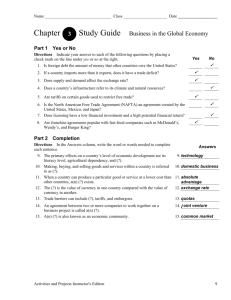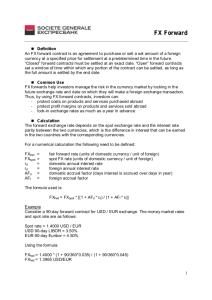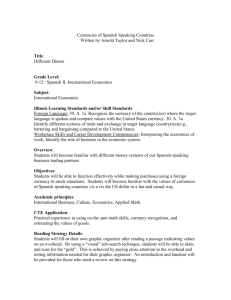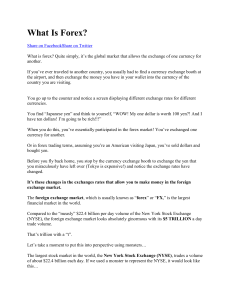Foreign Exchange Market
advertisement
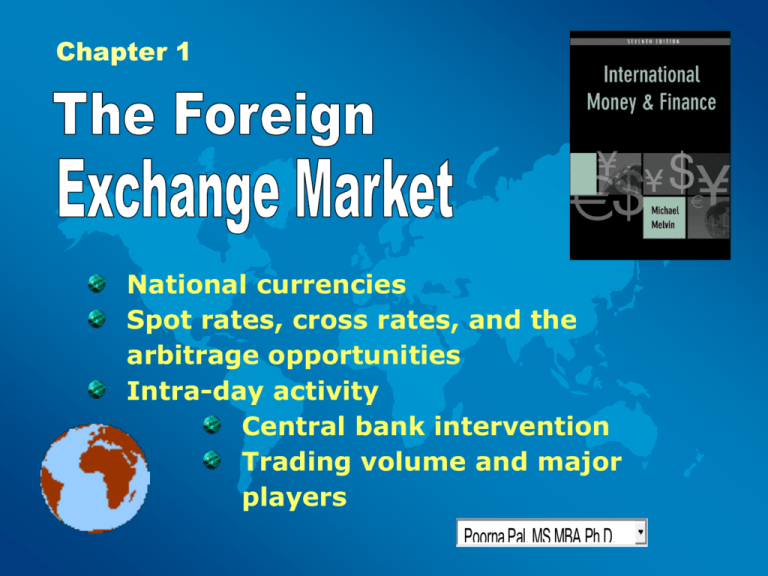
Chapter 1 National currencies Spot rates, cross rates, and the arbitrage opportunities Intra-day activity Central bank intervention Trading volume and major players Poorna Pal, MS MBA Ph.D. The currencies and currency symbols Currencies with their own special symbols: $ € The ISO codes of national currencies £ ¥ USD US dollar ISO (International Standards ₹ Organization) maintains the 2EUR Euro GBP British pound JPY Japanese yen AFN Afghanistan Afghani ALL Albanian Lek US Dollar Euro British Pound Japanese Yen Indian Rupee digits/3-digits codes for every country and its currency. Euro (EUR) is the common currency of the following European countries: Austria, Belgium, Cyprus, Finland, France, Germany, Greece, Ireland, Italy, Luxembourg, Malta, Netherlands, Portugal, Spain and Slovenia. World currencies Paper Currencies of the World http://www.xe.com/symbols.php#list Currencies of the world, by order of popularity http://www.xe.com/currency/ Spot rates and spreads Bid/offer spread (also known as bid/ask or buy/sell spread) for securities (such as stocks, futures contracts, options, or currency pairs) is the difference between the prices quoted (either by a single market maker or in a limit order book) for an immediate sale (ask) and an immediate purchase (bid). The size of the bid-offer spread in a security is a measure of the liquidity of the market and of the size of the transaction cost. Example: Currency spread If the current bid price for the EUR/USD currency pair is 1.5760 and the current ask price is 1.5763, this means that currently you can sell the EUR/USD at 1.5760 and buy at 1.5763. The difference between those prices is the spread. If the USD/JPY currency pair is currently trading at 101.89/92, that is another way of saying that the bid for the USD/JPY is 101.89 and the ask is 101.92. This means that currently, holders of USD can sell 1 USD for 101.89 JPY and investors who wish to buy dollars can do so at a cost of 101.92 JPY per 1 USD. Recent OANDA Spreads Select from the currency-pair list to see 7-day historical spread charts for any of the currency pairs available for trading at OANDA. Our prices are a true reflection of forex market pricing. We always publish tradable spreads—even when spreads widen due to market events or on weekends, when liquidity is scarce. Click the numbers in the charts to see market events that may have affected our spreads. OANDA also publishes real-time currency spreads and a comparison of spreads with other brokers. http://www.marketwatch.com/investing/currencies/tools Cross rates Cross Rate Calculation by csbhatnagar 1,395 views More on cross rates here http://www.marketwatch.com/investing/currencies/tools The Forex Market Never Sleeps Comparing Major World Indexes (March 9, 2009 to May 25, 2010) http://www.ritholtz.com/blog/2010/05/comparing-world-indices/ WALL STREET: MONEY NEVER SLEEPS Movie ... 7 min - Sep 8, 2010 Watch Ten Movie Clips from Oliver Stone's WALL STREET: MONEY NEVER SLEEPS Starring Michael Douglas, Shia LaBeouf ... Central Bank intervention can steady the exchange rate. Suppose US demand for Japanese goods Start with … • ¥100 = 1 $ exchange rate, and • demand and supply for $ as shown. increases. More $ now become available, so driving the exchange rate to ¥90 = 1 $. ¥/$ Exchange Rate D1 S1 100 90 $ Quantity As this appreciation of ¥ against $ hurts the Japanese sales, Bank of Japan can make ¥ cheaper by lowering Japanese interest rates or $ costlier by buying $, so restoring ¥100 = 1$ exchange rate. Global foreign exchange market turnover by instrument1 http://www.bis.org/publ/rpfx10.pdf 4 Options etc. 3 Foreign exchange swaps 2 Forwards 1 Spot transactions 2010 2007 2004 2001 1998 1995 1992 0 1989 trillion US$ at April 2010 exchange rate Average daily turnover, Global foreign exchange market turnover by instrument Source: Bank of International Settlements (http://www.bis.org/) Options etc. 3 Foreign exchange swaps 2 Forwards 1 Spot transactions 2010 2007 2004 2001 1998 1995 1992 0 1989 trillion US$ at April 2010 exchange rate Average daily turnover, 4 Source: Bank of International Settlements (http://www.bis.org/) Forex Trading Volume Minimizes Swings Oxford Analytica, 09.29.10, 06:00 AM EDT In most developed economies currency trading is such a huge market that no According to the Bank for Interone player can cause a national Settlements' April 2010 substantial surveys: move. • the euro/dollar market is trading over $1 trillion per day, and the • • overall market for dollar as a counterpart is worth $3.1 trillion/day. yen intervention faces a market worth $750 billion per day; and the Swiss National Bank is active in the Swiss franc today, while acknowledging that it can have little sustained impact in a market worth $240 billion per day. As the yen and Swiss franc show that even the "smaller" markets are too big to be influenced unilaterally. As neither Japanese nor Swiss efforts today would enjoy the support of a multilateral agreement to intervene, they are likely to have little more than brief effect on these currencies' values. Black Market versus Parallel Market The distinction between the parallel and the black markets is drawn along several related lines: how much is being sold, who is buying and who is selling, and where the transaction is taking place. The parallel market usually deals in large sums — many millions of dollars; it is often between businessmen and companies and, in the past, had bankers as its middle-men; and it takes place in offices and sometimes homes. Black market transactions happen on the streets, in the flea markets, and in back-rooms; sometimes for small sums of money like 20 US Dollars; and the deals often take place between individuals. The Forex Market: A layman's guide to how it works, and why it does what it does

